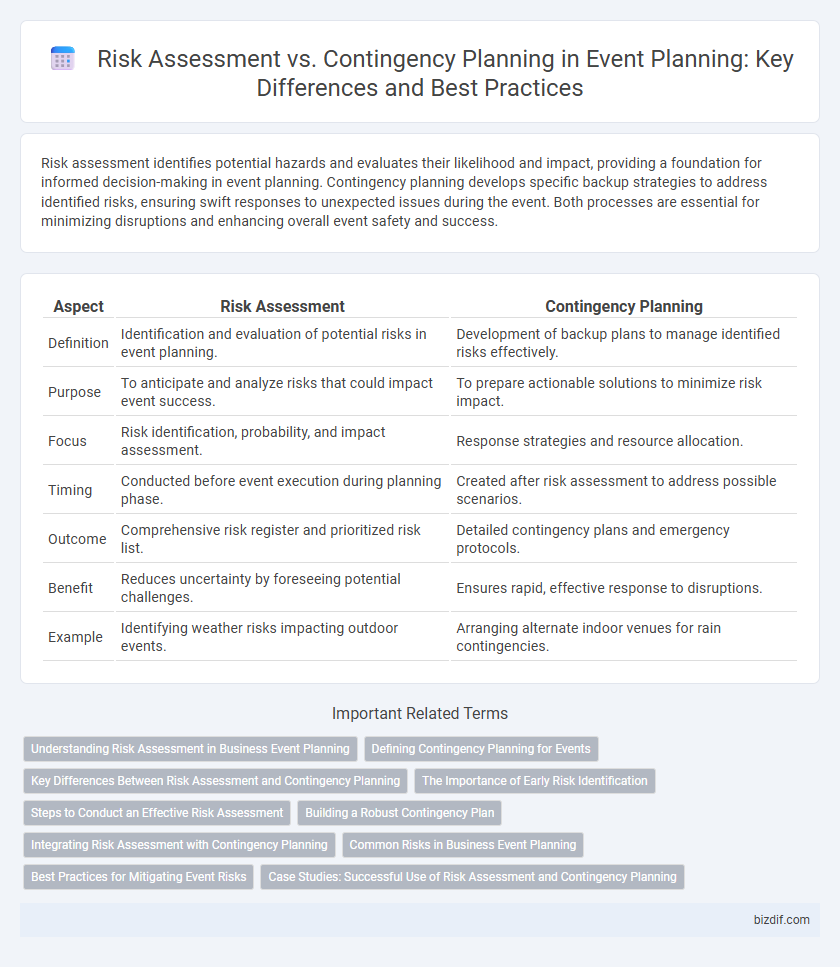Risk assessment identifies potential hazards and evaluates their likelihood and impact, providing a foundation for informed decision-making in event planning. Contingency planning develops specific backup strategies to address identified risks, ensuring swift responses to unexpected issues during the event. Both processes are essential for minimizing disruptions and enhancing overall event safety and success.
Table of Comparison
| Aspect | Risk Assessment | Contingency Planning |
|---|---|---|
| Definition | Identification and evaluation of potential risks in event planning. | Development of backup plans to manage identified risks effectively. |
| Purpose | To anticipate and analyze risks that could impact event success. | To prepare actionable solutions to minimize risk impact. |
| Focus | Risk identification, probability, and impact assessment. | Response strategies and resource allocation. |
| Timing | Conducted before event execution during planning phase. | Created after risk assessment to address possible scenarios. |
| Outcome | Comprehensive risk register and prioritized risk list. | Detailed contingency plans and emergency protocols. |
| Benefit | Reduces uncertainty by foreseeing potential challenges. | Ensures rapid, effective response to disruptions. |
| Example | Identifying weather risks impacting outdoor events. | Arranging alternate indoor venues for rain contingencies. |
Understanding Risk Assessment in Business Event Planning
Risk assessment in business event planning involves identifying potential hazards, evaluating their likelihood and impact, and prioritizing risks to develop effective mitigation strategies. This process enables event planners to foresee possible disruptions such as technical failures, weather issues, or security threats, ensuring resources are allocated to minimize adverse effects. Understanding risk assessment is crucial for maintaining smooth event execution and safeguarding stakeholder interests by proactively addressing vulnerabilities before the event occurs.
Defining Contingency Planning for Events
Contingency planning for events involves creating detailed backup strategies to address potential risks that may disrupt the event's success. It ensures preparedness by identifying alternative actions, resources, and communication plans to handle unforeseen circumstances such as weather changes, technical failures, or vendor cancellations. Effective contingency plans minimize impacts on event timelines, attendee experience, and budget while maintaining safety and operational continuity.
Key Differences Between Risk Assessment and Contingency Planning
Risk assessment involves identifying, analyzing, and evaluating potential hazards that could impact an event's success, focusing on the likelihood and severity of risks. Contingency planning prepares specific actions and protocols to mitigate or respond effectively to these identified risks if they occur. The key difference lies in risk assessment's predictive nature versus contingency planning's proactive response framework designed to minimize disruption during event execution.
The Importance of Early Risk Identification
Early risk identification is crucial in event planning as it enables event managers to recognize potential threats before they escalate, allowing for more effective risk assessment and resource allocation. By pinpointing risks early, contingency planning becomes more precise and tailored, minimizing disruptions and ensuring smoother event execution. This proactive approach significantly improves overall event safety and success rates.
Steps to Conduct an Effective Risk Assessment
Identify potential hazards associated with the event by analyzing the venue, activities, and external factors such as weather or crowd size. Evaluate the likelihood and impact of each risk through qualitative or quantitative methods to prioritize threats effectively. Develop risk mitigation strategies and document all findings to inform contingency plans, ensuring preparedness for unforeseen incidents.
Building a Robust Contingency Plan
Building a robust contingency plan in event planning involves identifying potential risks and developing actionable strategies to mitigate their impact effectively. Risk assessment provides the foundation by analyzing threats such as weather disruptions, technical failures, or vendor no-shows, enabling planners to allocate resources and backup solutions appropriately. A well-structured contingency plan ensures event continuity, minimizes downtime, and enhances stakeholder confidence through proactive problem-solving measures.
Integrating Risk Assessment with Contingency Planning
Integrating risk assessment with contingency planning enhances event management by identifying potential threats and preparing actionable responses to mitigate their impact. Detailed risk analysis enables event planners to allocate resources efficiently, ensuring that contingency measures address the most critical vulnerabilities. This proactive approach reduces disruptions, safeguards stakeholder interests, and promotes seamless event execution.
Common Risks in Business Event Planning
Common risks in business event planning include venue cancellations, technical failures, and low attendee turnout, which can significantly disrupt event success. Risk assessment involves identifying and evaluating these potential threats to develop proactive strategies. Contingency planning prepares backup solutions, such as alternative venues, IT support teams, and flexible scheduling, to mitigate impacts and ensure smooth event execution.
Best Practices for Mitigating Event Risks
Effective risk assessment identifies potential hazards in event planning by evaluating factors such as venue safety, weather conditions, and crowd management protocols. Contingency planning complements this by developing actionable backup strategies including alternative venues, emergency response teams, and communication plans to address identified risks. Integrating comprehensive risk assessment with detailed contingency plans ensures minimized disruptions and enhanced safety during events.
Case Studies: Successful Use of Risk Assessment and Contingency Planning
Case studies highlight how comprehensive risk assessment identifies potential hazards early, allowing event planners to develop effective contingency plans that ensure event continuity. For instance, the 2018 FIFA World Cup implemented detailed risk assessments for crowd control and transportation disruptions, paired with contingency plans that minimized delays and ensured attendee safety. These examples demonstrate that integrating risk assessment with contingency planning is critical for managing uncertainties and achieving successful event execution.
Risk assessment vs contingency planning Infographic

 bizdif.com
bizdif.com